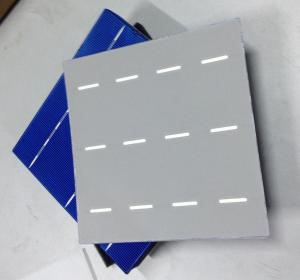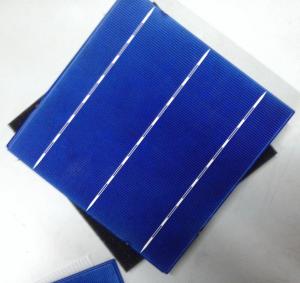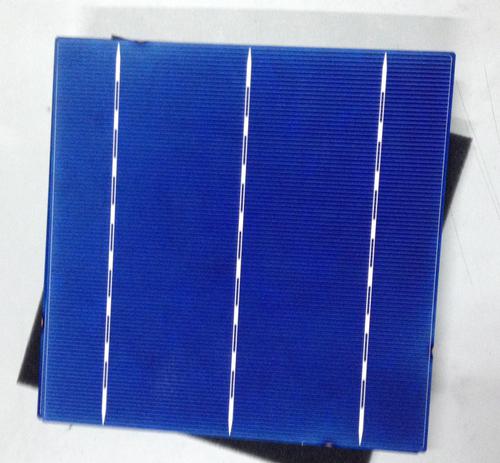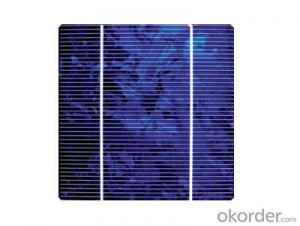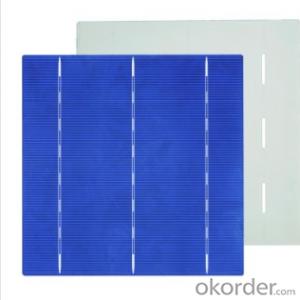Polycrystalline Silicon Solar Cell Type CSUN-M156-3BB-96
- Loading Port:
- China Main Port
- Payment Terms:
- TT or LC
- Min Order Qty:
- 5000 pc
- Supply Capability:
- -
OKorder Service Pledge
OKorder Financial Service
You Might Also Like
1. Structure of Polycrystalline Silicon Solar Cell Type CSUN-M156-3BB-96
A solar cell is an electrical device that converts the energy of light directly into electricity by the photovoltaic effect, which is a physical and chemical phenomenon. It is a form of photoelectric cell, defined as a device whose electrical characteristics, such as current, voltage, or resistance, vary when exposed to light. Solar cells are the building blocks of photovoltaic modules, otherwise known as solar panels. Solar cells are often electrically connected and encapsulated as a module. Photovoltaic modules often have a sheet of glass on the front (sun up) side, allowing light to pass while protecting the semiconductor wafers from abrasion and impact due to wind-driven debris, rain, hail, etc. Solar cells are also usually connected in series in modules, creating an additive voltage. Connecting cells in parallel will yield a higher current; our solar cells have passed IEC Certification. With high and stable quality, our cells can greatly improve the performance of Solar Modules.
2. Main Features of Polycrystalline Silicon Solar Cell Type CSUN-M156-3BB-96
1. Tire-1 Solar Cells’ Manufacturer Quality Guarantee. With a complete and sophisticated quality government system, our Quality Management have arrived world’s leading place. Customer can receive Tire-1 Cells Maker’s Quality Standard Products.
2. Trusted Warranty. We can supply trusted after-sales service to our customer. If our cells are found not in conformity to the specification of manufacturer, or should the inspected quantity found in shortage, or should the packing found damaged, the buyer has the right to claim to the seller. The claim, if any, should be presented to seller within 30 days after cargo's arrival date to the port, together with related inspection report and photos issued and provided by a reputable independent surveyor such as SGS.
3. World’s Leading Manufacturer Equipment. We imported the newest and leading production equipment from abroad. Advanced equipment can guarantee the stable quality of cells. Auto production line can also save labor cost which will further cut our production cost.
4. Bulk supply: With the production capacity of 500MW, we can produce large quantity every month. This can satisfy most customer requirement.
3. Polycrystalline Silicon Solar Cell Type CSUN-M156-3BB-96 Specifications
Format : 156 mm × 156 mm ± 0.5 mm
Thickness: 200 μm ±20 μm
Front (-) : 1.4mm bus bars (silver),blue anti-reflection coating (silicon nitride)
Back (+) : 1.8mm wide soldering pads (silver) back surface field (aluminium)
Efficiency (%) | Pmpp (W) | Umpp (V) | Impp (A) | Uoc (V) | Isc (A) | FF(1%) |
17.80-17.95 | 4.33 | 0.531 | 8.159 | 0.629 | 8.681 | 79.31 |
17.70-17.80 | 4.30 | 0.529 | 8.146 | 0.628 | 8.661 | 79.18 |
17.60-17.70 | 4.28 | 0.526 | 8.137 | 0.627 | 8.640 | 79.05 |
17.50-17.60 | 4.26 | 0.524 | 8.121 | 0.626 | 8.625 | 78.87 |
17.40-17.50 | 4.23 | 0.522 | 8.105 | 0.625 | 8.611 | 78.67 |
17.30-17.40 | 4.21 | 0.520 | 8.095 | 0.624 | 8.601 | 78.42 |
| 17.20-17.30 | 4.19 | 0.518 | 8.077 | 0.623 | 8.571 | 78.39 |
| 17.10-17.20 | 4.16 | 0.518 | 8.037 | 0.621 | 8.555 | 78.32 |
4. Polycrystalline Silicon Solar Cell Type CSUN-M156-3BB-96 Images
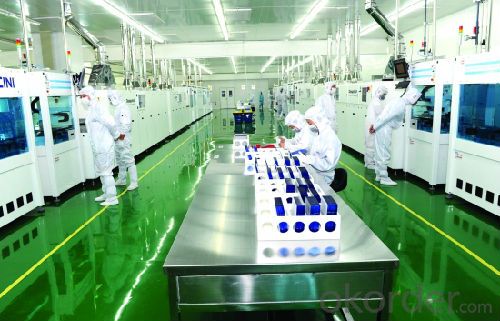
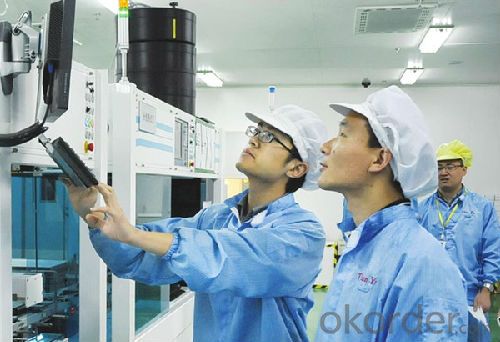
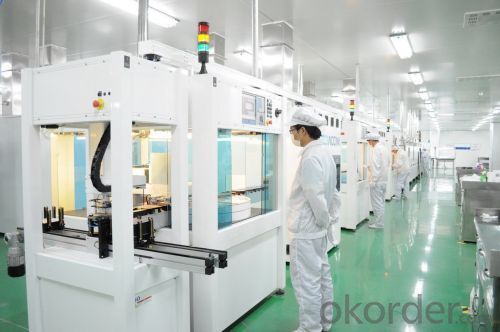
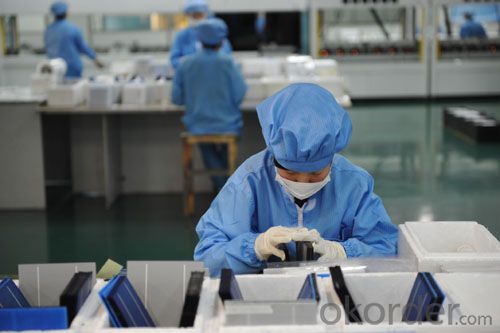
5. FAQ
Q1. How should you deliver the solar cells?
Re: We use carton box for packaging and deliver the solar cells by air in order to avoid the sunlight and moisture for the maximum degree.
Q2. How is your production and quality control?
Re: We use standard cells calibrated by Fraunhofer ISE and peel strength control.
- Q: Can solar cells be used in powering electric boats?
- Yes, solar cells can be used to power electric boats. Solar panels can be installed on the boat's surface to capture sunlight and convert it into electricity, which can then be used to power the boat's electric motor and other electrical systems. This enables the boat to operate without relying on traditional fuel sources, making it a more environmentally friendly and sustainable option.
- Q: The advantages and effects of solar energy
- The advantages of solar energy: solar energy as a new energy, it has three characteristics compared with conventional energy: First: it is the most abundant energy available to humans.It is estimated that in the past 1.1 billion years, the sun consumed Its own energy of 2% .In the future enough to supply the Earth human beings, the use of billions of year
- Q: How do solar cells handle snow or ice buildup?
- Solar cells do not handle snow or ice buildup well. When covered by snow or ice, solar cells are unable to absorb sunlight effectively, leading to reduced energy production. To prevent this issue, solar panels are often installed at an angle, allowing snow and ice to slide off more easily. Additionally, some solar systems use heating elements to melt snow or ice that accumulates on the panels.
- Q: Can solar cells be used to power irrigation systems?
- Yes, solar cells can be used to power irrigation systems. By converting sunlight into electricity, solar cells can effectively provide a sustainable and renewable energy source to operate irrigation systems, reducing reliance on traditional power sources and promoting eco-friendly practices.
- Q: How do solar cells perform in areas with high levels of pollen allergies?
- Solar cells are not directly affected by high levels of pollen allergies. However, if pollen accumulates on the surface of solar panels, it can potentially reduce their efficiency. Regular cleaning and maintenance can help mitigate any impact on performance in areas with high pollen allergies.
- Q: Can solar cells be used in underwater vehicles or submarines?
- Yes, solar cells can be used in underwater vehicles or submarines as a source of renewable energy. However, their efficiency can be significantly reduced due to the limited amount of sunlight that reaches underwater. Nonetheless, advancements in solar cell technology are being made to optimize their performance in such environments.
- Q: What is the usage of solar cells?
- Solar cells were first used as as an alternative power source to the primary battery power source.
- Q: Can solar cells be used to power large industrial facilities?
- Yes, solar cells can be used to power large industrial facilities. However, the feasibility and effectiveness of using solar cells for such facilities depend on factors such as the size of the facility, its energy requirements, available space for installing solar panels, and the cost-effectiveness of implementing and maintaining the solar power system.
- Q: Are solar cells safe for the environment?
- Yes, solar cells are safe for the environment. They generate electricity by converting sunlight into clean energy, emitting no greenhouse gases or air pollutants during operation. Additionally, the production and installation of solar cells have minimal environmental impact compared to conventional energy sources.
- Q: Do solar cells work at night or in low light conditions?
- No, solar cells do not work at night or in low light conditions as they rely on sunlight to generate electricity.
Send your message to us
Polycrystalline Silicon Solar Cell Type CSUN-M156-3BB-96
- Loading Port:
- China Main Port
- Payment Terms:
- TT or LC
- Min Order Qty:
- 5000 pc
- Supply Capability:
- -
OKorder Service Pledge
OKorder Financial Service
Similar products
Hot products
Hot Searches
Related keywords

